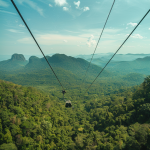Imagine an enchanting journey through the heart of nature, a serene escape that lifts you from the dense tapestry of Thailand’s forests to the mist-kissed peak of Phu Kradueng. A recent cabinet retreat nestled in the quaint province of Nong Bua Lamphu whispered life into a grand vision—a 28 million baht project promising such fairy-tale ascents through the birth of a cable car.
The buzz of this potential marvel filled the halls of power, yet the progress chart for this dreamy venture was a tale of mindful patience. The stewards of the nation’s treasure chest, colloquially known as the Budget Bureau, were tasked with the pivotal act of prioritization. The steel threads of the envisioned cable car dangled a question—could this wonder stir to life within the currents of the current government’s term? The mists of future’s uncertainty remained thick as a coastal fog.
With the verve characteristic of a politician melded with geographic pride, Puangpet Chunlaiad—a steadfast minister with heartstrings tethered to the land of Loei—insightfully dissected the journey of the funds sought. The bounty proposed was not a frivolous wish but a ledger of meticulous planning. It comprised drafting the skeletal designs of construction, and importantly, an environmental tapestry—a sworn oath to nature—the crucial Environmental Impact Assessment (EIA).
The nod of the Ministry of Natural Resources and Environment would set the cable car dream into its next stage, coursing through the veins of the Ministry of Tourism and Sports, before blooming into a topic of fervent discussion at the next cabinet’s gathering.
Admittedly, not every local’s heart sang in harmony at the idea of cable cars disrupting their verdant backyard. Yet, with the wisdom of dialogue and the promise of blooming prosperity, concerns morphed into a symphony of acceptance. The essence of the transformation lay in the promise that this mechanized chariot in the skies would bring forth year-round tourism and with it, the lifeblood of commerce to embolden the local populace. The noble cable car, a steel phoenix, promised a realm of splendor for the young at heart and a whispered solace to the weathered souls yearning to gaze into the horizon’s embrace without the climb.
The land upon which this vision cast its gaze is not one of the mundane. It is the venerable Phu Kradueng National Park—a majestic expanse lying in the arms of Loei’s tender Si Than district. Here, nature’s magnificence sprawls over a grand 348.13 square kilometers, where peaks play in a range from a modest 400 to the mighty stance of 1,300 meters above the whispers of the sea.
The sage of ascension to Phu Kradueng’s realms celestial has long stirred hearts and minds. Those advocating for the cable car weave dreams of taming the wilds to welcome throngs of eager tourists, hoping to tread lightly upon nature’s back. Their chords of reason pluck at the desire to safeguard the delicate waltz of boot upon soil from leaving too haunting a print.
Yet, every rose has its thorn; detractors cast wary eyes towards the skies, foretelling tales wherein nature’s portrait may bear the scars of progress and the teeming life below may pay the toll for the skies’ new conquerors.
The mountain’s siren song calls adventurers through trails that are as storied as they are varied—the widely-trodden main path, an 8.5 kilometers saunter, and the Pha Sam Yaek trail, a 10 kilometers test of will. The latter, the less chartered course, demands a dedication of 6-8 hours. Whispers told of porters, the unseen hands of the mountain, carrying life’s burdens skywards for those seeking the summit’s blessing.
In the heart of Thailand’s verdant embrace, the dance between progress and preservation continues—a delicate pirouette where the future of explorers and the hallowed grounds of Phu Kradueng whirl in anticipation of what the morrow may cradle in its bosom.


















Be First to Comment